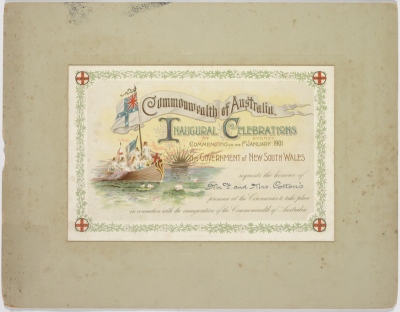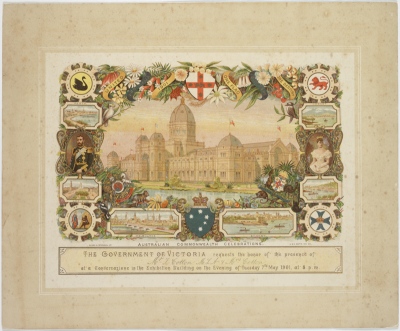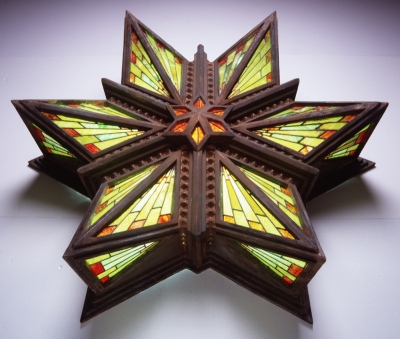THE COMMONWEALTH OF AUSTRALIA AND THE IMMIGRATION RESTRICTION ACT 1901

Invitations to Australian Commonwealth Celebrations, Francis Cotton, 1901. Courtesy State Library of New South Wales
I regard as second only to the necessity of protecting our shores against actual invasion, the necessity of protecting Australia against the influx of aliens, Asiatics, criminals, paupers, and other undesirable classes
– Charles Kingston, Premier of South Australia, 1891
Before 1900, there was no actual country called Australia, only the six colonies – New South Wales, Tasmania, South Australia, Victoria, Queensland, and Western Australia. While these colonies were on the same continent, they were governed like six rival countries and there was little communication between them. Until the 1880s, there was limited interest in the idea of uniting the colonies into one country and the influential businessmen in the colonies seemed more interested in protecting their own economic bases.
Things began to change in the 1890s as a severe drought resulted in a recession and violent industrial strikes. By 1888, 70% of the population had been born here and there was a growing nationalist sentiment. Communication had improved with the colonies linked to each other and the world by the Overland Telegraph and submarine cable. Germany, France and Russia were expanding in the Pacific and the colonies could better defend themselves with a single army and navy. Thousands of Chinese migrants came to Australia during the gold rush. People wanted to restrict the economic competition of migrants from Asia. The best way to do this was for all the colonies to act together and work out a common immigration policy.
Federation would deliver free trade between the states and protection from the rest of the world. It offered protection from imported goods and anyone who was not white. Apart from collecting the all important government revenue and preventing smuggling, Customs Officers were also entrusted with quarantine, immigration and the enforcement of the Passengers Act. Under the Passengers Act 1852 ships masters were required to keep accurate passenger lists which were verified before the ship was cleared by Customs and passengers could go ashore. Prior to 1852 there was no legal requirement to submit passenger lists.
Uniting the six colonies was not easy, with many fights and walkouts in negotiations along the way. After a series of conferences and meetings, a draft Australian Federal Constitution was drawn up. A series of referendums was put to the people until finally, in 1900, there was a majority agreement for Federation.

Invitation to Australian Commonwealth Celebrations, Francis Cotton, 1901. Courtesy State Library of New South Wales
The Commonwealth of Australia was proclaimed on 1 January 1901 at a grand ceremony in Sydney’s Centennial Park. Elections were held in March and the first Commonwealth Parliament was opened in Melbourne on 9 May 1901. The only women voting were those of South Australia and Western Australia. Campaigners for the women’s vote had hoped all women would be granted that right in time for Federation.
People were proud to be Australians and thought their country was the land of opportunity. Australia was part of the British Empire and in 1907 Australia, Canada, South Africa and New Zealand became known as dominions. However, while Australians elected a parliament that made Australian laws, Britain – the mother country – kept a firm control over defence and foreign policy. Australia did not have its own navy and could not make treaties with other nations.
But Australia was getting its own ideas. It was especially concerned that Britain did not have strong military bases in the Pacific and that Britain had signed a treaty with Japan which Australia feared. As a result, Australia began to build up its own navy in 1909.
In 1901, 98% of people in Australia were of British heritage. Australia wanted to remain a country of white people who lived by British customs. Trade unions were keen to prevent labour competition from Chinese and Pacific Islander migrants who they feared would undercut wages.
Consequently, one of the first pieces of legislation passed in the new Federal Parliament was the Immigration Restriction Act. Now known as the infamous White Australia Policy it, along with the Pacific Islander Labourers Act and the Post and Telegraph Act 1901, made it virtually impossible for Asians and Pacific Islanders to migrate to Australia.
This Act stated that if a person wanted to migrate to Australia they had to be given a ‘dictation test’ which could be in any European language. So a person from China or Japan who wanted to live in Australia could be tested in one or all of the French, Italian or English languages.
In 1905, the Act was changed so it could be given in any language at all. Of course, most Asians failed the test or were only allowed to enter the country under very strict exclusion rules or if they were fortunate enough to have well-connected sponsors.
The Dictation Test was used by customs officers as passengers came off the ships and paddle steamers and by police rounding up suspect illegal immigrants.
After the 1901 celebrations had faded the Federation needed a capital city. An American couple Walter Burly Griffin won a competition to design the nation’s capital on a remote sheep run in southern New South Wales bringing Art Deco and Art Moderne ideas to the Australian bush.


